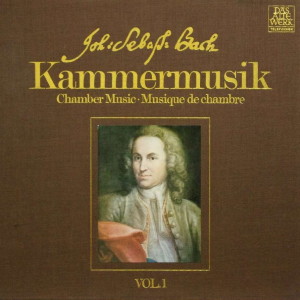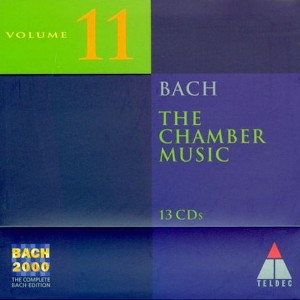 |
2 LP -
6.35310 EX - (p) 1976
|
 |
| 13 CD -
3984-25716-2 - (c) 1999 |
|
| Johann
Sebastian Bach (1685-1750) |
|
|
|
|
|
|
|
| Kammermusik - 6 Violinsonaten |
|
|
|
|
|
|
|
Sonata I h-moll, BWV 1014
|
|
11' 48" |
|
| - Adagio |
2' 53" |
|
A1 |
| - Allegro |
2' 46" |
|
A2 |
| - Andante |
2' 50" |
|
A3 |
| - Allegro |
3' 19" |
|
A4 |
| Sonata II A-dur, BWV 1015 |
|
13' 27" |
|
| - (Adagio) |
2' 45" |
|
A5 |
- Allegro assai
|
3' 04" |
|
A6 |
- Andante un poco
|
3' 06" |
|
B1 |
| - Presto |
4' 32" |
|
B2 |
| Sonata III E-dur, BWV 1016 |
|
13' 25" |
|
- Adagio
|
3' 33"
|
|
B3 |
| - Allegro |
2' 47" |
|
B4 |
- Adagio ma non tanto
|
4' 37" |
|
B5 |
| - Allegro |
3' 44" |
|
B6 |
| Sonate IV c-moll, BWV 1017 |
|
14' 59" |
|
- Largo, Siciliano
|
3' 27" |
|
C1 |
| - Allegro |
4' 24" |
|
C2 |
- Adagio
|
2' 30" |
|
C3 |
| - Allegro |
4' 38" |
|
C4 |
| Sonata V f-moll, BWV 1018 |
|
14' 56" |
|
- Lamento
|
5' 34" |
|
C5 |
| - Allegro |
4' 21" |
|
C6 |
- Adagio
|
2' 40" |
|
D1 |
- Vivace
|
2' 21" |
|
D2 |
| Sonata VI G-dur, BWV 1019 |
|
16' 07" |
|
- Allegro vivace
|
3' 31" |
|
D3 |
| - Largo |
1' 25" |
|
D4 |
| - Allegro (Cembalo solo) |
4' 54" |
|
D5 |
| - Adagio |
3' 01" |
|
D6 |
| - Allegro assai |
3' 16" |
|
D7 |
|
|
|
|
| Alice
Harnoncourt, Violine
(Jacobus Stainer, Absam 1665) |
|
| Nikolaus
Harnoncourt, Viola da
Gambe (Jacob Precheisn, Wien 1670) |
|
| Herbert
Tachezi, Cembalo (Martin
Skowroneck, Bremen 1973, in
französischer Bauweise) |
|
|
Luogo
e data di registrazione
|
Sankt
Georgen im Attergau
(Austria) - 1975
|
|
Registrazione
live / studio
|
| studio |
Producer
/ Engineer
|
-
|
Prima Edizione CD
|
Teldec
"Bach 2000" - 3984-25716-2 - (13 cd) -
70' 57" + 16' 14" - (c) 1999 - ADD
|
|
Prima
Edizione LP
|
Telefunken "Das
Alte Werk" - 6.35310 EX - (2
lp) - 41'
16"
+ 46' 20"
- (p) 1976
|
|
Note
|
| Il
volume 11 della "Bach 2000" contiene 13
cd's. Le 6 Sonate per Violino BWV
1014-1019 sono contenute nel cd 7
(tracce 1-20) ed 8 (tracce 1-5). |
|
|
Notes on the
performance
|
In
our recorded performance the
bass line of the obbligato
harpsichord part was
reinforced by a viola da
gamba. Reinforcement, albeit
with a cello, was normally
only usual in the case of
works with basso continuo in
order to bring out the outer
parts (bass and solo upper
part), with the fill-in
chords of the harpsichord
(organ, long archlute etc.)
receding into the
background. As regards
ohbligato harpsichord parts
(as for instance in the slow
movements of the Triple
Concerto or the 5th
Brandenburg Concerto) Bach
expressly waived
reinforcement of this kind.
However, one of the seven
important sources (the only
one with autograph pages in
the harpsichord part) refers
to the composer’s wish for
reinforcement of the bass
line with Viola da
Gamba, “if so desired”
(“...per Viola da Gamba se
piace”). This remark is so
unusual as regards style and
makes performance so much
more difficult that we
cannot assume that it was
entered by a copyist. One
can more likely conclude
that it was a very modern
idea on Bach’s part, his
intention being to make the
three-part movement - which
dominates in these sonates -
more colourful and
outstanding by brightening
up one of the two
harpsichord parts which
otherwise would sound the
same: firstly violin,
secondly harpsidiord and
thirdly viola da
gamba/harpsichord. Of all
the stringed instruments in
the bass position, the viola
da garnba is most suitable
for this purpose because it
sounds much more gentle than
the cello and its tone fuses
mudm more easily with that
of the harpsichord. For many
movements in which the
equality of the parts is not
so pronounced, where the
bass of the harpsichord has
more of a continuo
character, the
bass-reinforced sound
pattern is in any case the
“norm.”
Bach's
idea, if we accept that the
note stems from the
composer, already points to
the early Haydn and Mozart
piano trios, where the cello
has a similar function to
the viola da gamba in the
present case.
Sonata II, 2nd movement,
bars 12 and 104, the e” is
already played on the second
crotchet and tied to the
next bar (according to three
of the six sources
concerning the violin part);
bar 23, last quaver, instead
of b', e" (tied over) is
played for analogous reasons
and on the basis of the J.
Ch. Altnikol copy, the rnain
source of the New Bach
Edition; for the same
reasons in bar 41 the last
three semi-quaver notes are
played as b” e” and a#”. Bar
92, on the basis of two
sources the chord is played
as e' b' g#”. Sonata III, 1st
movement, bar 17: the
rhythmic structure of the
sources varies considerably
here; a “certain
approximation”, a quasi
improvisando, is evidently
intended. 4th movement,
where they are not the
motif, but are performing an
accompanying function, the
quaver notes in the bass are
adapted to the triplets of
the violin part (bars 35 to
77), as is also noted in
some of the sources. 3rd
movement, the dotted quavers
and semi-quavers of the
violin part and of the bass
are adapted to the triplet
motion.
Sonata VI, movement in bar
32 (harpsichord) and 54
(violin) is played in
accordance with the main
sources:

Bar 79, printing error: the
fourth note
of the violin part should be
a semiquaver.
Naturally the note values,
as Well as the
interpretation of the
arpeggios, are performed not
on the basis of the music
pattern but according to the
practical performance
convention of that period.
The articulation was
supplemented according to
the various sources and the
practical performance
principles of the Bach era.
Nikolaus
Harnoncourt
English
translations by Frederick
A. Bishop
|
|
Nikolaus
Harnoncourt (1929-2016)
|

|

|
|